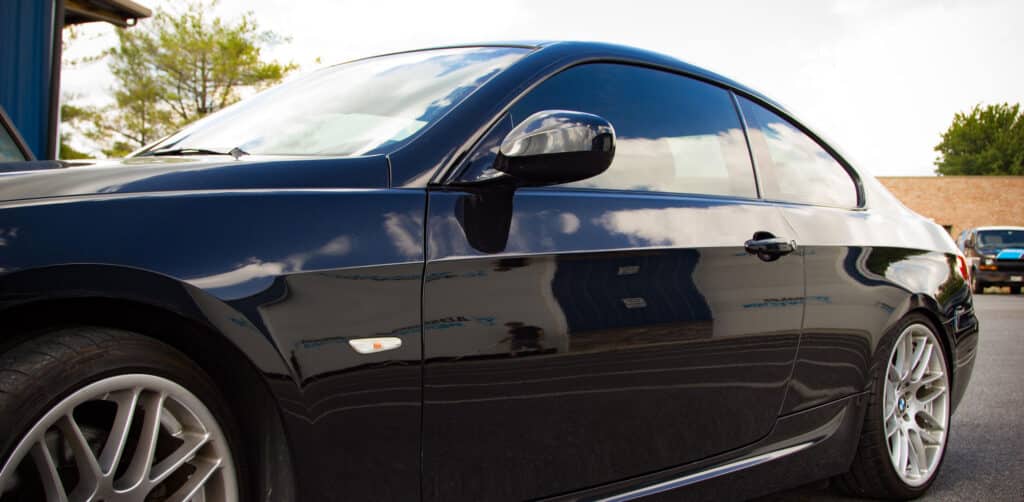Established in 1991 and revised in 2017, the tint laws in New York put forth several rules and regulations surrounding the legality of tinted car windows in the state.
There’s no denying that tinted windows look sleek and that they’re a great way to shelter yourself and your car’s interiors from heat and sunlight.
But there are good reasons why window tinting is regulated. This was done to help maintain road safety and to make it easier for law enforcement officials to identify the occupants of every vehicle they come across.
In this guide, we’ll take a closer look at what these laws are and how you can get your car windows tinted legally in New York.
Is Window Tint Legal in New York?

According to the tint laws in NY, window tint is entirely legal. However, there’s a limit to how dark it can be. It’s worth mentioning that the transparency of your windows is measurable.
In fact, the 2017 revision of this law requires officials to inspect and examine the extent of window tinting whenever they carry out regular inspections of motor vehicles.
The New York law on window tinting is not necessarily uniform for all kinds of vehicles and windows. For instance, owning a sedan might require you to follow a different set of rules as compared to owning an SUV or a van.
Similarly, the tinting limits for windshields and the driver’s window might be different in comparison to some of the other windows in your car.
Permitted Window Tint Darkness

How dark your tint can be depends on several factors such as window position and the type of car you drive.
The transparency of your windows is measured with the help of a unit called visible light transmission or VLT. Darker tints are rated at lower VLT% and lighter tints are rated at higher VLT%.
As an example, if the VLT of the window tint is 10%, this means that only 10% of the light can pass through it, blocking the remaining 90%.
In contrast, if the VLT is 60%, 60% of the light can pass through, while the remaining 40% gets prevented from entering.
Below you’ll find New York’s mandated VLT percentages.
Sedans
Windshield: You can use a non-reflective tint on the top 6 inches that allows for 70% VLT.
Driver-side windows: 70% VLT is necessary.
Passenger-side windows: 70% VLT is necessary.
Rear window: There are no controls in place here as long as you have dual side mirrors.
SUVs and Vans

Windshield: You can use a non-reflective tint on the top 6 inches that allows for 70% VLT.
Driver-side windows: 70% VLT is necessary.
Passenger-side windows: You can use any extent of darkness.
Rear window: You can use any extent of darkness.
Acceptable Tint Reflection
Tint reflection is another characteristic of window tint film that’s regulated. As opposed to tint darkness and VLT, which has to do with how much light can pass through the tint, reflection is more about the amount of light that doesn’t make it into the cabin.
States generally have regulations in place for the level of tint reflection as well, especially because it makes it difficult for law enforcement officials to identify the occupants. This can differ from one state to another.

Usually, tints that are more metallic can end up reflecting more light as compared to those that are not. In New York, metallic or overly reflective window tints aren’t permitted.
Other New York Tint Rules You Need to Know
Here are some additional regulations that you should be aware of.
Color: You can use any tint color.
Manufacturer label: No certification is required for the film.
Side mirror: You need both side mirrors if you tint the windows at the back.
Medical exceptions: You can apply for a medical exemption through a physician’s recommendations and signature on the official form.
Sticker: You should have a sticker in place before applying the tint.
Penalties: You can be fined up to $150.
Note that although you can use any tint color, you cannot use metallic or mirrored tints, which might end up putting a few restrictions on the color as well.
Make sure you opt for a manufacturer who is aware of each of these restrictions so that you can stay away from legal trouble or from getting pulled over and fined.
If there are further differences in the counties themselves, you should be aware of these and apply the tint accordingly.
It’s worth remembering that neighboring states have different rules as well. If you find yourself crossing the border often, remember to check out our other guides to:
- tint laws in Pennsylvania,
- New Jersey tint rules,
- tint laws in Connecticut,
- MA tint laws, and
- tint requirements in Vermont.
State of New York Info

The State of New York lies in the northeastern part of the country.
It comprises New York City, a major hub in the country as well as the world for a wide range of industries, resulting in its huge impact on the economy of the state.
Rochester, Albany, Syracuse and Buffalo are some other major cities. The state has 62 counties. It ranks 27th in terms of its size among the other states in the country and also has one of the largest populations in the United States.
Population: 19,835,913
Capital: Albany
Registered vehicles: 10,255,099
Total lane miles: 240,489
Number of highways: 31
Tint law references: Department of Motor Vehicles
Medical exemption info: NY DMV Application Form

